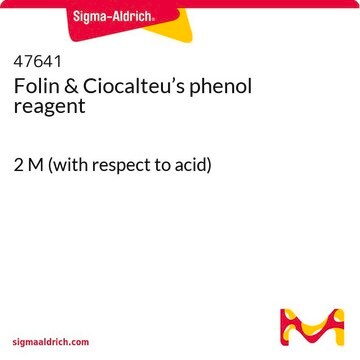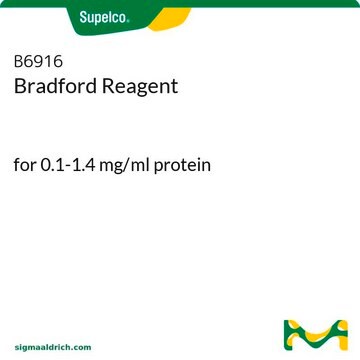This product is not tested according the BP or JP guidelines. This reagent is not recommended for the determination of phenols. HIstorically, the performance of this product in the determination of phenolic compounds, typically run in wineries, has proven to be unpredictable. It is recommended for use primarily in Lowry protein determination.
F9252
Folin & Ciocalteu′s phenol reagent
suitable for determination of total protein by Lowry method, 1.9-2.1 N
Select a Size
About This Item
Recommended Products
form
liquid
Quality Level
concentration
1.9-2.1 N
color
clear yellow
faint yellow to very dark yellow, and Faint Green-Yellow to Very Dark Green-Yellow
pH
<0.5 (20 °C)
density
1.240 g/cm3 at 20 °C
suitability
suitable for determination of total protein by Lowry method
application(s)
diagnostic assay manufacturing
hematology
histology
storage temp.
room temp
Looking for similar products? Visit Product Comparison Guide
General description
stabilized with sodium potassium tartrate). Addition of the phenol reagent generates chromogens that give increasing absorbance between 550-750nm. Normally, absorbance at the peak (750nm) or shoulder (660nm) are used to quantitate protein concentrations between 1-100 mg/ml while absorbance at 550nm is used to quantitate higher protein concentrations.
In the absence of copper, color intensity is determined primarily by the tyrosine and tryptophan content of the protein, and to a lesser extent by cysteine and histidine. Copper(II) has no effect on color formation by tyrosine, tryptophan, or histidine, but reduces color formation due to cysteine.[1][4][5][6][7]
Many modifications of the original assay procedure have been published,[4] including methods for enhancing the color development,[6][8] for determining the content of insoluble proteins,[1][9] and for automating the procedure.[10] Compounds including many buffers, chelating agents, detergents, and cyclic organic compounds can interfere with the Lowry protein assay.[4]
Folin & Ciocalteu′s phenol reagent can also be used as a spray reagent in chromatographic procedures.
Application
Other Notes
Linkage
related product
Signal Word
Danger
Hazard Statements
Precautionary Statements
Hazard Classifications
Eye Dam. 1 - Met. Corr. 1 - Skin Corr. 1
Storage Class Code
8B - Non-combustible corrosive hazardous materials
WGK
WGK 2
Flash Point(F)
Not applicable
Flash Point(C)
Not applicable
Choose from one of the most recent versions:
Already Own This Product?
Find documentation for the products that you have recently purchased in the Document Library.
Customers Also Viewed
Protocols
To standardize a procedure for the determination of protein by modified Lowry.
Evaluate PCR inhibitors and enzyme selection using GenElute™-E Single Spin Plant Extraction Kit, KOD-One™ PCR Master Mix, and competitors.
Proteinase K activity measured via spectrophotometry using hemoglobin substrate, crucial for enzyme characterization.
Related Content
Products for traditional and alternative protein quantitation techniques available, including BCA, Bradford, Lowry, and more.
-
We have received Folin & Ciocalteus phenol reagent F9252-100mL, PCode: 102600991, Source: BCCJ8511 from Sigma(Merck). Is the reagent suitable for Phenol content determination? Is the reagent prepare by following BP/EP?
1 answer-
Helpful?
-
-
貴社が販売しているFolin & Ciocalteuフェノール試薬は毒物や劇物に該当しないとの認識でよろしいでしょうか。
1 answer-
The information requested can be found on the Product Safety Data Sheet. The document can be downloaded from the top right-hand side of the Product Detail Page under ‘Documents’. A Safety Data Sheet can also be downloaded from the following link: https://www.sigmaaldrich.com/search
Please refer to Section 2 for the various hazards associated with this material. The bottle label will show a "Danger" pictogram and is considered a dangerous product.
Helpful?
-
-
How do I differentiate the spectrophotometric result obtained from this reagent is either because of reaction with phenols or non-phenolic reducing substances? Thanks.
1 answer-
The type and amount of non-phenolic compounds present is a given sample will determine the impact on the total phenol values. The use of a standard curve is critical. Factors such as pH adjustment can minimize the effects. Reducing compounds may be identified and quantified separately or removed from the sample by various means. See the links below to review several publications that may be useful.
https://waterhouse.ucdavis.edu/folin-ciocalteau-micro-method-total-phenol-wine
https://www.mdpi.com/2076-3417/13/4/2135
https://pubs.rsc.org/en/content/articlelanding/2013/ay/c3ay41125g
https://link.springer.com/chapter/10.1007/978-3-319-45776-5_25Additional assistance can be provided by our Technical Service team who can assist you further. We kindly ask you to navigate to the link https://www.sigmaaldrich.com/techservice, click on "Product Technical Inquires" under the Products Section with all the required information so that a member of our team can reach out to you to assist further. Thank you.
Helpful?
-
-
What concentrations of proteins does Product F9252, Folin & Ciocalteu's phenol reagent, detect?
1 answer-
Generally, Folin & Ciocalteu's phenol reagent is used to determine protein concentrations between 1 to 100 μg/mL. However, the reagent exhibits a linear response to protein concentration up to 1000 μg/mL when used according to the instructions for kit Product No. TP0200.
Helpful?
-
-
Can Product F9252, Folin & Ciocalteu's phenol reagent, be used to detect any protein?
1 answer-
If the protein has an abnormally low tyrosine content, this method would not be suitable.
Helpful?
-
-
What is the Department of Transportation shipping information for this product?
1 answer-
Transportation information can be found in Section 14 of the product's (M)SDS.To access the shipping information for this material, use the link on the product detail page for the product.
Helpful?
-
-
Does Product F9252, Folin & Ciocalteu's phenol reagent, contain phenol?
1 answer-
The Folin & Ciocalteu's phenol reagent does not contain phenol but reacts with phenol and non-phenolic reducing substances to form chromogens that can be detected spectrophotometrically.
Helpful?
-
-
What should Product F9252, Folin & Ciocalteu's phenol reagent, look like?
1 answer-
The Folin & Ciocalteu's phenol reagent should be a clear yellow solution. If the solution turns green, it may not be suitable and it should not be used.
Helpful?
-
Active Filters
Our team of scientists has experience in all areas of research including Life Science, Material Science, Chemical Synthesis, Chromatography, Analytical and many others.
Contact Technical Service











